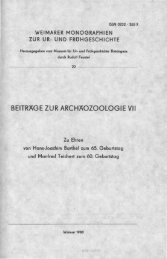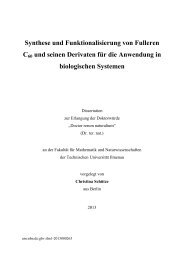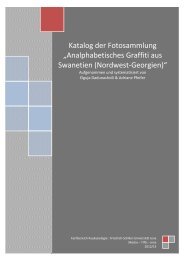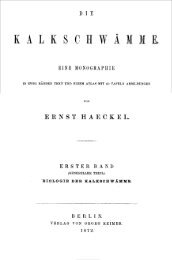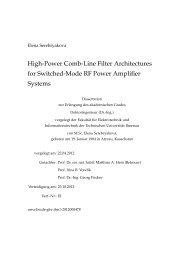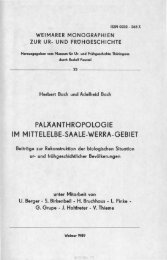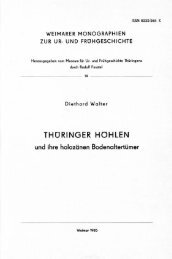Dissertation
Dissertation
Dissertation
You also want an ePaper? Increase the reach of your titles
YUMPU automatically turns print PDFs into web optimized ePapers that Google loves.
|3.3 NN-NHC-Ligand bbip: Toward Second Generation Catalysts|<br />
ground and excited states for all complexes reveal very similar features in terms of reactivity and<br />
stability regardless of the absence or presence of Ag, Rh, or, most importantly, Pd at the NHCcoordination<br />
sphere of the Ru(bbip)M complexes.<br />
3.3.9 Excited State Dynamics of the bbip-Containing Ruthenium Complexes<br />
In addition to the steady state experiments, time-resolved transient emission and absorption<br />
measurements were performed for the series of Ru(bbip)M complexes (M = f: metal free, Ag:<br />
silver, Pd: palladium, Rh: rhodium). The following photophysical results were obtained in a<br />
cooperation with Katrin Peuntinger from the work group of Prof. Guldi (FAU Erlangen-<br />
Nürnberg) and might be found in her PhD thesis in a similar form.<br />
With the help of transient emission experiments it was possible to determine the emission<br />
lifetimes in oxygen free acetonitrile and dichloromethane (see table 14). In acetonitrile, the<br />
Ru(bbip)-derived silver and palladium complexes exhibit, with deviations, quantitatively similar<br />
lifetimes as observed for Ru(phen) (τ M = Pd<br />
ACN<br />
M = Ag<br />
Ru(phen)<br />
= 1100 ns, τ = 1450 ns, and τ = 1400 ns).<br />
ACN<br />
The parent compound Ru(bbip) and the rhodium complex possess significantly shorter lifetimes<br />
(τ M = Rh<br />
ACN<br />
M = f<br />
= 430 ns and τ = 920 ns). In oxygen free dichloromethane, only the rhodium complex<br />
ACN<br />
exhibits a significantly shortened lifetime (τ M = Rh<br />
DCM<br />
ACN<br />
M = Pd,Ag,f<br />
= 900 ns < τ ≈ 1400 ns). Data from<br />
aerated samples were collected for Ru(bbip) and Ru(bbip)Ag, but are not necessarily reasonable<br />
for the air and moisture sensitive silver complex. Nevertheless, lifetimes of roughly 200 ns were<br />
determined in acetonitrile and values of 550 and 400 ns were found in dichloromethane for the<br />
mono- and binuclear complex, respectively. These values are in good accordance to the previously<br />
determined values of Ru(phen).<br />
The transient absorption experiments were started with a comparative study of 1 MLCT absorption<br />
behavior of the monometallic complex Ru(bbip) and the potential bimetallic catalyst Ru(bbip)Pd.<br />
Using femtosecond experiments (see figure 103) shed light exclusively onto the early stages<br />
of the MLCT excited state formation (i.e., 480 nm, 150 fs). In line with literature results (cf.<br />
[Ru(bpy) 3 ] 2+[41] ), it was observed in both complexes how the initial formed 1 MLCT excited states of<br />
Ru(bbip) and Ru(bbip)Pd rapidly underwent intersystem crossings to the corresponding triplet<br />
manifold (τ Ru(bbip)<br />
ISC<br />
≈ τ Ru(bbip)Pd<br />
ISC<br />
ACN<br />
< 150 fs, as observed at λ = 560 nm). Absorption characteristics of<br />
the former include the typical minima (ground state bleach) at λ = 443 nm and maxima (excited<br />
|145|



